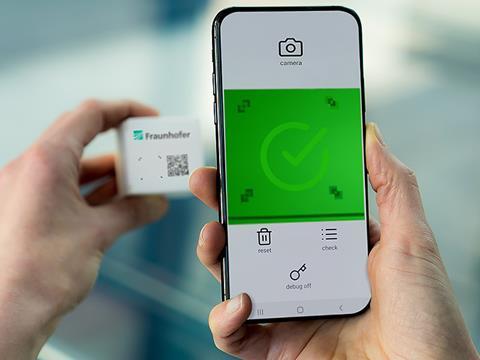
At Interpack 2023, the Fraunhofer team will present a demonstrator for a counterfeit-proof barcode system called SmartID. In the SmartID project, the Fraunhofer Institutes for Applied Polymer Research (IAP), Secure Information Technology (SIT) and Open Communication Systems are developing a novel labelling system to uniquely verify and authenticate products via smartphone, they say.
Counterfeits of high-quality products such as medicines, cosmetics, watches, or even food and beverages circulate in large numbers, especially in online retail. Consumers have little chance to verify the authenticity of a product in this marketplace.
So, scientists at Fraunhofer are now developing a counterfeit-proof barcode system for authenticity verification simply by using a smartphone without accessing a database. The team is presenting the solution at Interpack 2023 from May 4-10 2023 in Düsseldorf at Hall 4, Booth C54 (the VDMA-booth
The solution takes advantage of the fact that every package possesses a unique, characteristic surface texture. The texture is comparable to a human fingerprint and can be detected by standard smartphone cameras, which scans the printed barcode and, at the same time, the texture of the surface.
The barcode already contains information about the texture. A specially developed app compares whether the information stored in the barcode matches the data from the scanned surface, so a tamper-proof barcode is created.
The SmartID labelling system was designed in such a way that it not only serves to authenticate the product, but may also contain additional information about it. The system is also easy to integrate into commercial printing processes during the manufacture of the packaging, says Fraunhofer.
“With this technology, everyone in the supply chain - from the manufacturer to the end consumer - will be able to check with a smartphone app whether a product bearing the SmartID code is genuine. The special thing here is that the app operates offline, so without access to a database and without a connection to the internet,” Dr. Tobias Jochum explains. Jochum is the coordinator of the project at the Fraunhofer Center for Applied Nanotechnology (CAN) in Hamburg, a research unit of the Fraunhofer IAP.
For manufacturers, there is another advantage as no IT infrastructures have to be set up. Since there is no need to use a central database, various IT security and data protection challenges are not required, the organisation claims. In addition, there are no costs associated with the installation, commissioning and maintenance of databases.
Konrad Öchsner, innovation manager at Koenig & Bauer Coding and new advisory board member of the SmartID consortium, explains, “The complexity of the IT infrastructure can be significantly reduced. Also, by avoiding the operation of databases or blockchain applications, no additional carbon dioxide is released, reducing the carbon footprint.”
“An important requirement for SmartID barcodes is that they occupy as small an area as possible,” Jochum says. “As the project progresses, we are optimizing the system in terms of its required area and also its sensitivity. In this context, quantum materials play a key role. They enable significantly more features of the surface texture to be detected on a smaller area.”
This article was created in collaboration with AIPIA (the Active and Intelligent Packaging Industry Association). For a full update on active and intelligent packaging, come along to the AIPIA World Congress (co-organized by Packaging Europe) in Amsterdam on 14-15 November. The only smart packaging event covering the entire technology spectrum, the World Congress is a meeting place for the global active and intelligent packaging industry where brand owners, innovators, and other stakeholders can network and see and discuss the latest trends and innovations. Register to attend here.











No comments yet